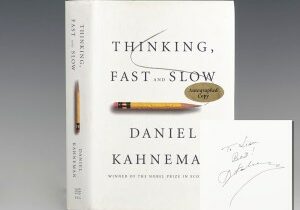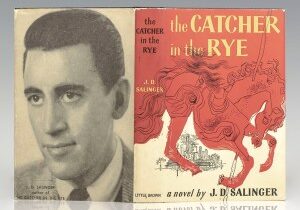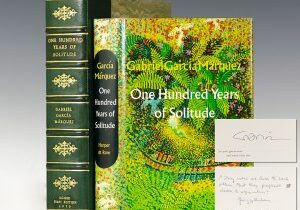Widely considered the most significant book published in the history of modern science, Charles Darwin‘s magnum opus On the Origin of Species attracted widespread attention upon publication on Thursday, November 24, 1859. Priced at fifteen shillings and with a first print run of only 1,250 copies, the book sold out on the day of publication, necessitating the swift publication of a second edition, released only months later on January 7, 1860.

Scarce First Edition, Presentation Copy of Charles Darwin’s On the Origin of Species; inscribed in a secretarial hand to the Secretary to the Bombay Geographical Society, Dr. George Buist
Of the 1,250 copies produced in the first printing, 58 were distributed by the publisher for review, 500 were taken by Mudie’s Library, and less than 30 were likely distributed as presentation copies. The second edition, with a print run of 3,000 copies incorporated numerous revisions as well as Darwin’s response to the religious community’s objections to his theories.
Based primarily on Darwin’s research and observations recorded during his survey expeditions aboard the HMS Beagle, On the Origin of Species introduced Darwin’s theory of evolutionary biology which asserted that populations evolve over the course of generations through a process of natural selection. The book presented a body of evidence that the diversity of life arose by common descent through a branching pattern of evolution which Darwin referred to as “the great Tree of life … with its ever branching and beautiful ramifications.”

Darwin’s Evolutionary Tree Diagram illustrating the evolution of species over several thousand generations; found in the first edition of The Origin of Species
“The five years [of Darwin’s voyage on the Beagle] were the most important event in Darwin’s intellectual life and in the history of biological science. Darwin sailed with no formal training. He returned a hard-headed man of science… The experiences of his five years in the Beagle, how he dealt with them, and what they led to, built up into a process of epoch-making importance in the history of thought” (PMM).

Journal of Researches into the Natural History and Geology of the Countries Visited During the Voyage of H.M.S. Beagle Round the World
There was growing support for various evolutionary ideas in mid 19th century England, however ideas about the transmutation of species were controversial as they conflicted with the Church of England’s theological explanation of the origin of mankind which argued that humans were unique and unrelated to other animals.
Within two decades there was widespread scientific agreement that evolution, with a branching pattern of common descent, had occurred, but scientists were slow to give natural selection the significance that Darwin thought appropriate. In 1871, he published his second book on evolutionary theory, The Descent of Man, and Selection in Relation to Sex which applied his evolutionary theory to human evolution, particularly detailing his theory of sexual selection which sparked debate and opposition, notably from his contemporary Alfred Russell Wallace who argued that the notion of female mate choice was attributing the ability to judge standards of beauty to animals far too cognitively undeveloped to be capable of aesthetic feeling.

Finely bound set of the Works of Charles Darwin; bound in full morocco with the gilt seal of the Law Society of the United Kingdom
On the Origin of Species remains one of the most revolutionary and important works of scientific literature ever published. Darwin truly “revolutionized our methods of thinking and our outlook on the natural order of things. The recognition that constant change is the order of the universe had been finally established and a vast step forward in the uniformity of nature had been taken” (PMM 344). In addition to the rare first editions featured above, our collection currently includes an exquisitely bound set of The Works of Charles Darwin bound for Law Society of the United Kingdom, a rare original carte-de-visite of Charles Darwin framed with his signature, and many others.












